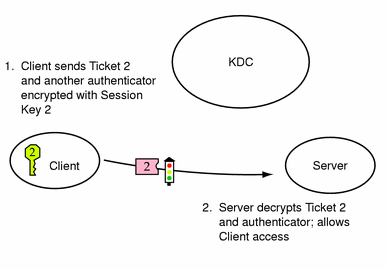Gaining Access to a Service Using SEAM
In order for a user to access a specific service on a specific server, the user must obtain two things. The first is a credential for the ticket-granting service (known as the TGT). Once the ticket-granting service has decrypted this credential, the service creates a second credential for the server for which the user requests access. This second credential can then be used to request access to the service on the server. After the server has successfully decrypted the second credential, the user is given access. This process is described in more detail below, and in the figures that follow.
Obtaining a Credential for the Ticket-Granting Service
-
To start the authentication process, the client sends a request to the authentication server for a specific user principal. This request is sent without encryption. There is no secure information included in the request, so it is not necessary to use encryption.
-
When the request is received by the authentication service, the principal name of the user is looked up in the KDC database. If a principal matches, the authentication service obtains the private key for that principal. The authentication service then generates a session key to be used by the client and the ticket-granting service (call it session key 1) and a ticket for the ticket-granting service (ticket 1). This ticket is also known as the ticket-granting ticket (TGT). Both the session key and the ticket are encrypted using the user's private key, and the information is sent back to the client.
-
The client uses this information to decrypt session key 1 and ticket 1, using the private key for the user principal. Since the private key should only be known by the user and the KDC database, the information in the packet should be safe. The client stores the information in the credentials cache.
Normally during this process, a user is prompted for a password. If the password entered is the same as the one used to build the private key stored in the KDC database, then the client can successfully decrypt the information sent by the authentication service. Now the client has a credential to be used with the ticket-granting service. The client is ready to request a credential for a server.
Figure 23-2 Obtaining a Credential for the Ticket-Granting Service

Obtaining a Credential for a Server
-
To request access to a specific server, a client must first have obtained a credential for that server from the authentication service (see "Obtaining a Credential for the Ticket-Granting Service"). The client then sends a request to the ticket-granting service, which includes the service principal name, ticket 1, and an authenticator encrypted with session key 1. Ticket 1 was originally encrypted by the authentication service using the service key of the ticket-granting service.
-
Because the service key of the ticket-granting service is known to the ticket-granting service, ticket 1 can be decrypted. The information included in ticket 1 includes session key 1, so the ticket-granting service can decrypt the authenticator. At this point, the user principal is authenticated with the ticket-granting service.
-
Once the authentication is successful, the ticket-granting service generates a session key for the user principal and the server (session key 2) and a ticket for the server (ticket 2). Session key 2 and ticket 2 are then encrypted using session key 1. Since session key 1 is known only to the client and the ticket-granting service, this information is secure and can be safely set over the net.
-
When the client receives this information packet, it decrypts the information using session key 1, which it had stored in the credential cache. The client has obtained a credential to be used with the server. Now the client is ready to request access to a particular service on that server.
Figure 23-3 Obtaining a Credential for a Server

Obtaining Access to a Specific Service
-
To request access to a specific service, the client must first have obtained a credential for the ticket-granting service from the authentication server, and a server credential from the ticket-granting service (see "Obtaining a Credential for the Ticket-Granting Service" and "Obtaining a Credential for a Server"). The client can send a request to the server including ticket 2 and another authenticator. The authenticator is encrypted using session key 2.
-
Ticket 2 was encrypted by the ticket-granting service with the service key for the service. Since the service key is known by the service principal, the service can decrypt ticket 2 and get session key 2. Session key 2 can then be used to decrypt the authenticator. If the authenticator is successfully decrypted, the client is given access to the service.
Figure 23-4 Obtaining Access to a Specific Service

- © 2010, Oracle Corporation and/or its affiliates
